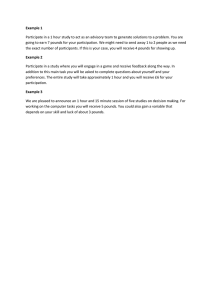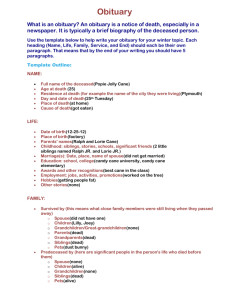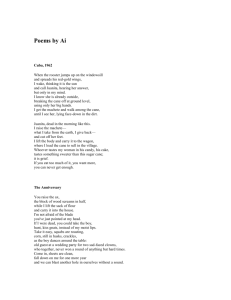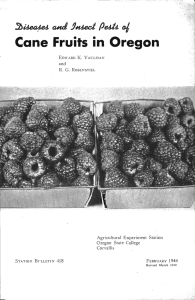Sa ' I iseases
advertisement
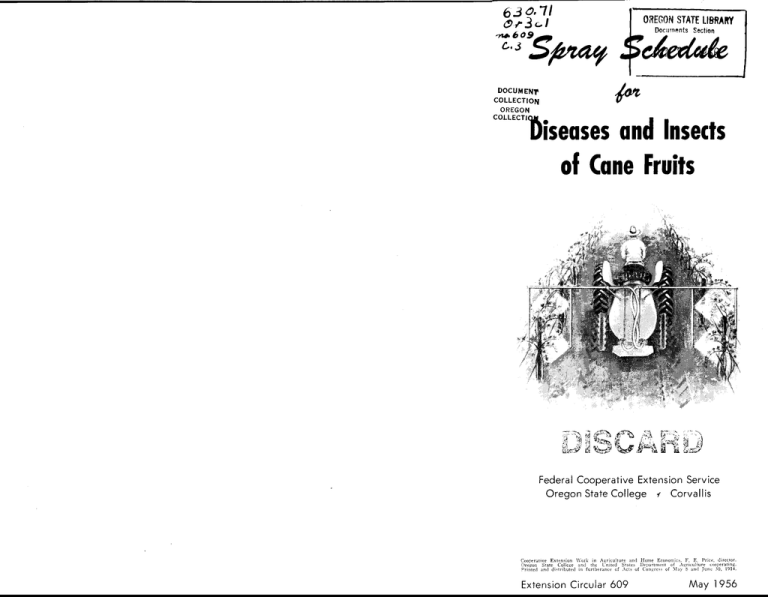
6 ' '' OREGON STATE LI8RAY a". 3 Sa Documents Section 609 DOCUMENit COLLECTION U OR EGO N COLLECTI iseases and Insects of Cane Fruits C S4 5lS o,_.! 4e7 'a 4 Jt;, 5S'' , , : T'4 5,5w : ;:' , 'a p '1'S ; 4' cS SSSs,S,4i 0 ;i S CS, 'l 4,5 3 I 4, Federal Cooperative Extension Service Oregon State College i Corvallis Cooperative Extension \\'orh- in Agriculture and Home Economics. P. F., Price, director. Oregon Srate College and she United Staten Department of Agrtculsornceoprrattng, Oriotrd ansi distributed so fortherance of Acts of Congress of Mac S and Junc .30, Extension Circular 609 1914. May 1 956 ISEASE AND INSECT CONTROL increases yield and improves quality of cane fruits. Oregon cane fruits are subject to insect and disease damagemost of which can be controlled with a planned spray program. A dormant spray of lime sulfur or polysulfide, preferably in February or early in March, is the Time of application Spring first step in a spray program for all cane fruits. All dead or diseased canes should be removed Insect or disease Anthracnose New canes 10 inches to 12 inches high: Lime sulfur 2V2 gallons or polysulfide 3 pounds. Leaf and cane spot March 10 to 15: Lime sulfur 8 gallons or ferbam 1 Y2 pounds. Two weeks later: Captan 1 /2 pounds or ferbam 1 V2 pounds. Add 2 ounces spreader sticker to all sprays. Powdery mildew Control not known. Above sulfur sprays help. Sulfur injures plants in warm weather. Yellow rust Green tip stage: Lime sulfur 4 gallons or polysulfide 5 and destroyed. Some of the more common insects and diseases of cane fruits in Oregon are discussed in this leaflet. INSECTS pounds. Two weeks later: Lime sulfur 2V2 gallons, polysulflde 3 pounds, or ferbam 1 V2 pounds. If weather continues humid, 1 /2 pounds ferbam just before blossoming. Oblique-banded Leafroller Active, green larvae with black heads. Control with DDT in early May before blossoming. If later sprays needed, do not apply within 21 days of harvest. TDE not effective against leafroller. Late spring and summer Orange Tortrix Active, yellow-green larvae with brown heads. Control with IDE (DDD). Apply May 1 to 10 when larvae present. If later applications needed, do not apply Oblique-banded leaf roller 5% DDT dust, 40 pounds per acre; or 2 pounds 50% DDT wettable powder. Apply early May before blossoming. Do not apply within 21 days of harvest. Orange tortrix 5% TDE dust, 40 pounds per acre; or 2 pounds 50% IDE wettable powder. Apply May 1 to 10. Do not apply within within 21 days of harvest. Strawberry Root Weevils Of the cane fruits, red raspberries are most susceptible to damage by root weevils. New plantings can be protected for several years by application of insecticides to the soil before planting. See Station Circular of Infor- Material and strength* 21 days of harvest. Fall Strawberry root weevils Use weevil bait. Adults most numerous June and July. Blackberry mite Summer oil emulsion 3 gallons. Apply after old canes removed. Needed only in case of severe red berry condition. Can be added to Bordeaux spray. mation 546, "Strawberry Root Weevil Control," for details of this treatment. For established plantings, use Leaf and cane spot weevil bait. Apply bait to kill adult weevils which are Remove and burn affected canes after harvest. Bordeaux 8-8-100 about September 15. most numerous from early June to July. Raspberry Cane Maggot An occasional pest of red and black raspberries. Presence of insect indicated by canes which wilt and droop in "Limberneck" fashion. Cut off wilted canes close to ground and burn. Strawberry Crown Moth Black raspberries most susceptible. Whitish larvae tunnel in crown and larger roots. No control recommended at present. Raspberry root borer 4 pounds 50% DDT wettable powder. Make second application same rate, to 2 weeks later. 1 Winter (dormant) Blackberry mite and scale, anthracnose, powdery mildew, cane blights, leaf and cane spot Lime sulfur 10 gallons, or polysulfide 12 pounds. * Amounts of spray chemicals recommended are to be mixed with sufficient water to make up 100 gallons of spray. Example: The 3 gallons of mer oil emulsion for blackberry mite control in the fall should be mixed with 97 gallons of water. sum- Raspberry Root Borer Cut off wilted canes close to the crown and burn. DDT sprays applied in late September and again week later to lower canes and crowns have shown promise of control in experimental trials. 1 Santiam, Chehalem, and the common wild trailing blackberry. Where the disease is particularly severe, the fall spray of Bordeaux should be applied in addition to the dormant and spring sprays. Mushroom Root Rot (all cane berries) Blackberry Mite Attacks Himalaya and Evergreen blackberries. Presence Decline and dieback of the plant--eventual killing. of this pest indicated by berries which do not ripen normally and remain red and hard after harvest. White, felt-like masses of fungus between the bark and wood in crown of plant. Dark brown or black Scale thread-like strands are often found on plants at ground level or just below. Remove and destroy plants (small Rose scale most common. Appears as small white scaly spots on canes. Usually held in check by lime fungus can live in the soil for many years. Autumn: honey colored mushrooms in crown of plants. roots as well). Do not replant in affected spots. The sulfur or polysulfide sprays in the winter or spring. Powdery Mildew (red, black, and purple raspberry and some blackberries) DISEASES Anthracnose (black and red raspberry) On canes, small, Va-inch or more, purplish sunken spots, later turn gray. Older spots are deeper with raised purplish margins. The disease is not always severe enough to warrant the cost of spraying. Cane Gall Small, rough ridges of warty growth on fruiting canes. Affects the red, black, and purple raspberry, Himalaya, Boysenberry, Loganberry and Youngberry. Best control is by setting out disease-free plants from healthy plantings, in soil free from the causal bacterium. Remove and burn severely diseased plants. Remove the con- taminated soil about these plants and replace with clean soil. When the disease is not severe, cut out the affected canes and burn. Avoid injury to the plants. The causal bacterium will persist in soil for 5 or 6 years after the susceptible plants are removed. Crown Gall Irregular, warty galls on the base of canes or on the roots. Affects all cane fruits as well as many woody shrubs and fruit trees. Use control practices recommended for cane gall. Whitish-gray powdery mass on leaves, fruit, young canes, fruit spurs, and buds. Verticillium Wilt (most cane berries) Yellowing and wilting of foliage. Bluish strips of infected tissue usually extend up the canes from ground level. Himalaya, Evergreen, and wild trailing blackberries seem to be highly resistant. Plant healthy stock from disease-free plantings. Roguing, and rotations of nonsusceptible grasses and cereals help. Avoid planting where susceptible crops potatoes, tomatoes, eggplants, peppers, strawberries, and peacheshave been grown previoUsly. Virus Diseases To control virus diseases (1) use disease-free planting stock, (2) rogue out and destroy suspicious or diseased plants. When more than 5 per cent of the plants in the field are diseased, the value of roguing is doubtful. Yellow Rust (red raspberrysome varieties) Yellow pustules on both surfaces of leaves in spring and summer. Also on canes. Black pustules on underside of leaves in autumn. Two spring sprays of lime sulfur, polysulfide, or ferbam usually give controlsee spray program. Leaf and Cane Spot (trailing berries) Small, light to dark brown spots on both leaves and canes. Later, spots have whitish center, brownish border. Severe on Loganberry, Boysenberry, Youngberry, This circular was prepared by P. W. Every, Extension Entomology Specialist, and I. C. MacSwan, Extension Plant Pathology Specialist, Oregon State College. 8M 5-56
